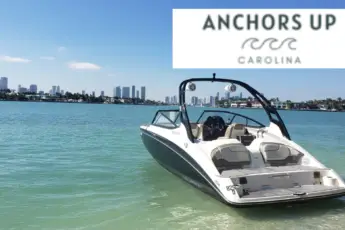During the warm summer months one of the most entertaining watersports is tubing. Undoubtedly, tubing is suitable for a multitude of age levels. If you’re new to boating and water tubing it is essential to understand the basics. Remember, tubing can be dangerous if you don’t remain mindful of the steps and hazards. Here are 6 things to know about how to pull a tube behind a boat.
Connecting The Tow Line
Without question, depending on the make of the vessel, the point of connection for the tow line varies.
Boat tube tow lines are connected to the vessel in one of two ways. First is stainless steel clips attaching to U-Bolts affixed to the port and starboard side of the stern.
The second is by connecting the eye of the tow rope to a verticle pylon at the aft of the vessel.
Importantly, no matter the connection point, ensure that the clips or eye is appropriately secured to prevent the rope from coming free when tension is applied.
Boarding The Tuber
Believe it or not, one of the most dangerous points of water tubing is transitioning between the boat and the tube.
Unquestionably, a passenger on the vessel must be available to assist the tuber into the tube. The person assisting holds the tube tight against the boat allowing the tuber to enter the float safely.
Conversely, the person boarding the tube is prone to slipping and falling without assistance. The stern of a boat has protruding objects such as the engine, cleats, ladders, and more. Making contact with any of these is likely to cause significant injury.
Deploying The Tow Line
It should be noted that the driver should never deploy the tow line. Instead, a passenger must be available to pay out the line for safety purposes.
The boat’s passenger serves two purposes when paying out the line. First, ensuring the tuber is far enough from the engine before shifting the boat forward to avoid injury. The second is to prevent the propeller from entangling the tow line. A tow line tangled within the prop will take a significant amount of time to remove. For this reason, I recommend having a helping hand to guide the line free of the propeller.
Monitoring The Person(s) In The Tube
Importantly, the operator of the vessel should not monitor the person in the tube. Instead, a passenger onboard should keep their eyes facing aft.
Without question, a passenger must watch the tuber at all times in the event they fall out. In a situation where the tuber goes overboard, the person monitoring should keep their eyes on the person who fell overboard and guide the driver.
Driving The Boat
The driver, in comparison, is similar to the spotter facing aft. Conversely, the driver is solely responsible for safely navigating the boat as a tuber is pulled behind.
Without a doubt, the operator is under the most pressure to ensure all passengers remain safe. Always look for floating objects, other vessels, wakes, and markers.
Lastly, monitor your speed. I recommend towing the tube at 20 MPH as this is a safe operating speed. Pushing the boat above 25 MPH puts the person at risk of becoming injured by being bounced from waves or falling out.
Retrieving An Overboard Tuber
No doubt about it, tubers will fall out and require a pickup from the tow boat. Understanding how to approach the person in the water is paramount to avoid injury.
First, after a person falls overboard from the float, reduce the engine speed, turn towards the person, and have the spotter quickly pull the tube back into the boat.
Secondly, continue to drive toward the person floating in the water. Monitor the wind speed and direction. Slowly, pull the boat upwind of the person so you are about five to ten feet from them.
Next, put the vessel in neutral and shut off the engine, allowing the boat to drift within feet of the person so they can swim to the stern.
Lastly, deploy the swim ladder and have a passenger assist the tuber back into the boat.
Now You Know How To Pull A Tube Behind A Boat
Understanding these six fundamentals will help ensure that your tubing trips run smoothly each and every time. One of the most significant factors when engaging in watersports is ensuring everyone onboard the boat and tuber remains safe. Importantly, monitor your speed as it may creep up on you when you’re focused on the water ahead as the driver. Lastly, its a good idea to have everyone on the vessel wear a life jacket.







